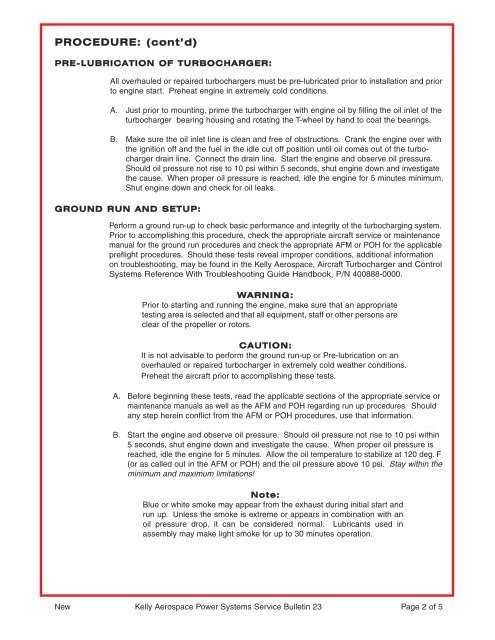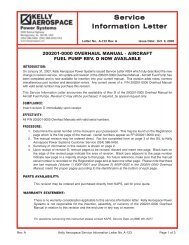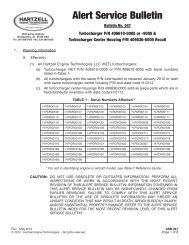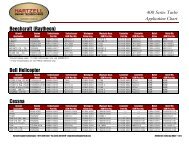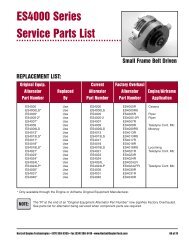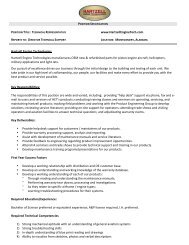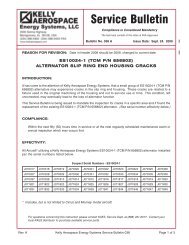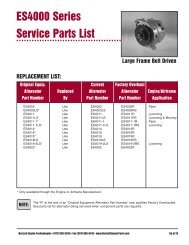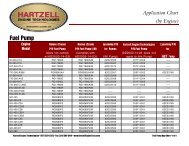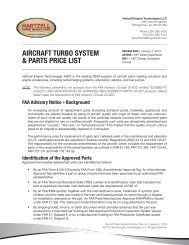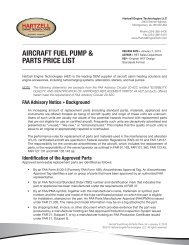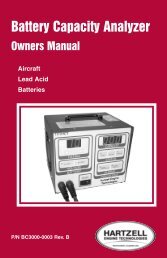Service Bulletin - Hartzell Engine Technologies
Service Bulletin - Hartzell Engine Technologies
Service Bulletin - Hartzell Engine Technologies
You also want an ePaper? Increase the reach of your titles
YUMPU automatically turns print PDFs into web optimized ePapers that Google loves.
PROCEDURE: (cont’d)<br />
PRE-LUBRICATION OF TURBOCHARGER:<br />
All overhauled or repaired turbochargers must be pre-lubricated prior to installation and prior<br />
to engine start. Preheat engine in extremely cold conditions.<br />
A. Just prior to mounting, prime the turbocharger with engine oil by filling the oil inlet of the<br />
turbocharger bearing housing and rotating the T-wheel by hand to coat the bearings.<br />
B. Make sure the oil inlet line is clean and free of obstructions. Crank the engine over with<br />
the ignition off and the fuel in the idle cut off position until oil comes out of the turbocharger<br />
drain line. Connect the drain line. Start the engine and observe oil pressure.<br />
Should oil pressure not rise to 10 psi within 5 seconds, shut engine down and investigate<br />
the cause. When proper oil pressure is reached, idle the engine for 5 minutes minimum.<br />
Shut engine down and check for oil leaks.<br />
GROUND RUN AND SETUP:<br />
Perform a ground run-up to check basic performance and integrity of the turbocharging system.<br />
Prior to accomplishing this procedure, check the appropriate aircraft service or maintenance<br />
manual for the ground run procedures and check the appropriate AFM or POH for the applicable<br />
preflight procedures. Should these tests reveal improper conditions, additional information<br />
on troubleshooting, may be found in the Kelly Aerospace, Aircraft Turbocharger and Control<br />
Systems Reference With Troubleshooting Guide Handbook, P/N 400888-0000.<br />
WARNING:<br />
Prior to starting and running the engine, make sure that an appropriate<br />
testing area is selected and that all equipment, staff or other persons are<br />
clear of the propeller or rotors.<br />
CAUTION:<br />
It is not advisable to perform the ground run-up or Pre-lubrication on an<br />
overhauled or repaired turbocharger in extremely cold weather conditions.<br />
Preheat the aircraft prior to accomplishing these tests.<br />
A. Before beginning these tests, read the applicable sections of the appropriate service or<br />
maintenance manuals as well as the AFM and POH regarding run up procedures. Should<br />
any step herein conflict from the AFM or POH procedures, use that information.<br />
B. Start the engine and observe oil pressure. Should oil pressure not rise to 10 psi within<br />
5 seconds, shut engine down and investigate the cause. When proper oil pressure is<br />
reached, idle the engine for 5 minutes. Allow the oil temperature to stabilize at 120 deg. F<br />
(or as called out in the AFM or POH) and the oil pressure above 10 psi. Stay within the<br />
minimum and maximum limitations!<br />
Note:<br />
Blue or white smoke may appear from the exhaust during initial start and<br />
run up. Unless the smoke is extreme or appears in combination with an<br />
oil pressure drop, it can be considered normal. Lubricants used in<br />
assembly may make light smoke for up to 30 minutes operation.<br />
New Kelly Aerospace Power Systems <strong>Service</strong> <strong>Bulletin</strong> 23 Page 2 of 5


